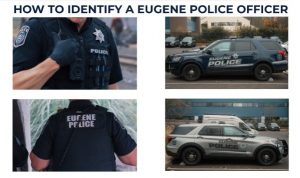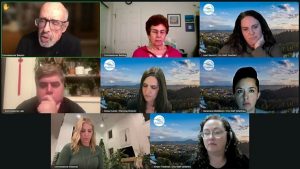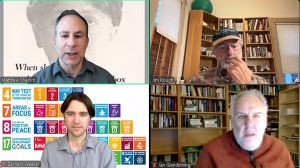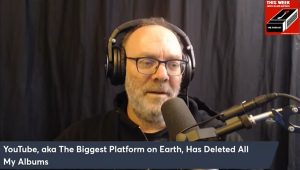Stories of Bridgeway House: Kassie Holcomb and Tresa Roberts
7 min read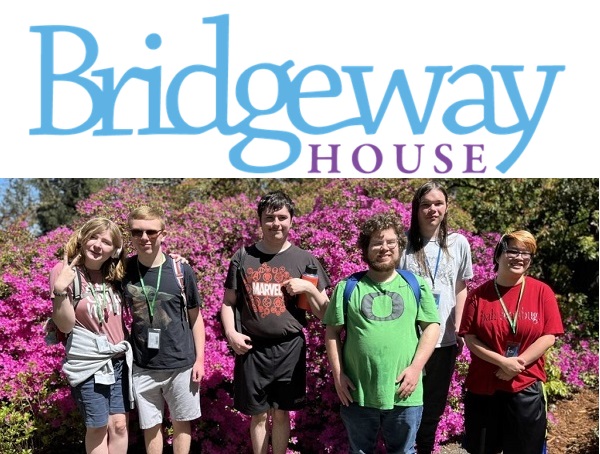
Presenter: To celebrate Autistic Pride Day June 18, we’re visiting with the community at Bridgeway House, a critical educational resource serving 90 students and their families from 17 school districts. Here are teachers Tresa Roberts and Kassie Holcomb:
Kassie Holcomb: My name is Kassie Holcomb. I am a parent and a teacher at Bridgeway House. What’s so special about Bridgeway House is that we’re really placing and meeting them where their needs are at, rather than trying to make them fit into a mold or meeting them wherever they need to go.
So we don’t go by specific grade level. We go by where what classroom would fit the best. So I currently have 13- to 18-year-olds in my class.
Tresa Roberts: And I’m Tresa Roberts, and I’m a teacher at Bridgeway. And I have nine, let’s say, seven- to 13-year-olds.
[00:00:54] Presenter: Bridgeway has two sites: one downtown and one at Camp Creek. Teacher Kassie Holcomb:
[00:01:00] Kassie Holcomb: I am at this facility downtown where I currently teach, and my son since kindergarten was at the Camp Creek location, and actually Tresa taught with him for a while too, and he has just transitioned to this location, so lots of changes.
[00:01:14] But we’ve been a part of the Bridgeway family since the very beginning. It’s really changed our life. We were scared of, you know, when we got to school age, time or age, I guess we could say, we were worried about: What’s this going to look like? You know, the public school could not serve his needs, could not offer supports.
[00:01:37] And when we learned about his diagnosis around two years old, we also learned that this might be a fight, to find services for him, to really get what he needs, because he is severely affected by autism. When I met with Patricia when he was four and a half years old, it was like a light at the end of the tunnel.
[00:01:57] You know, she welcomed us with open arms, reassured that it was okay, that it would be a journey that we would experience together. So from that time on, Bridgeway really became a huge part of my family. He was met where he was at and he started with going just for a couple hours and was in Gina’s class.
[00:02:21] And I remember them telling me that he was too anxious to join the classroom, so he would just pace back and forth in the hallway for an hour and they were willing to do that with him, which was pretty great.
[00:02:33] He wasn’t potty-trained. I didn’t know if he would ever achieve that, but they were willing to help guide him for the next five years and we were able to get there at 10 years old, you know?
[00:02:45] So it’s really been, I couldn’t have done any of this without the support of Bridgeway that led me into the profession as well, to be a part of this community and to serve students that are affected with different abilities and that don’t fit the small mold that the public school tries to fit us all into.
[00:03:05] So, very thankful, and I couldn’t imagine what this community and outside districts, what they would do if we didn’t have Bridgeway. So it’s been a very huge part of my personal and professional life at this point.
[00:03:20] I was in general education until I found out about my son’s diagnosis and really shifted my pathway there, and obviously became very passionate about the community—such a compassionate group of students and kids and young adults that I think are often not given the chance to shine. They’re expected to fit into this mold that is not typical.
[00:03:48] But Bridgeway really finds a way to focus on their strengths and help them to live the best life possible. So, very thankful for that.
[00:03:57] Presenter: Tresa Roberts:
[00:03:58] Tresa Roberts: I do not have a child affected by autism, but, I kind of stumbled my way into this profession. I was teaching early childhood and was looking for a job and somebody said, you know, we have this job at this autistic school, which was on the East Coast. So this has been quite a journey for me.
[00:04:17] But when I came here, I had already kind of looked around to see if there were any other schools like the one I was working at and there was Bridgeway. So when I got here, the job was sort of familiar to me, as I was supporting and teaching and encouraging children on the spectrum.
[00:04:33] But what really wasn’t that familiar was like the passion that I felt when I came here. Well, it’s built on that, like Patricia started it. She wasn’t educated as a business person or an educator or any of that. So this all was birthed from passion and a love for this community of children.
[00:04:53] And so you really feel that when you come here and you see that the teachers here will go that extra mile, and do what they need to do, so that these kids can have an experience that other kids are just given without question. And we have to look at them differently.
[00:05:10] And I always say, you know, like a lot of people will come in the school and they’ll hear kids screaming and you’re like, ‘Oh my gosh, what’s going on?’
[00:05:18] But when we hear that, we don’t hear screaming. We hear kids that are trying to regulate, trying to just make it through the day, get through the next minute. And they may see people hitting walls and stuff, and again, it’s like they—we just see people who are just trying to, you know, show their frustration. They can’t get their needs met, you know, and sometimes that’s hard to get across to somebody.
[00:05:41] So just having that and knowing that they have that here at Bridgeway, where they can be accepted for who they are, understood, that they think differently. And that’s what we do. We try to figure out how they think and then how can we teach ’em so they can learn that way.
[00:05:57] And so I think that’s the big thing for me is just the passion and everything that comes from Bridgeway. It’s just birthed out of love and compassion. And it shows, it really does.
And when Patricia stepped away for a little while, you could feel it. It’s huge and I am so grateful that she’s come back. (Yes.) Because we really need her. And that’s just a big piece of what we are and what we do.
[00:06:22] Presenter: Kassie Holcomb:
[00:06:23] Kassie Holcomb: Embodying the spirit of Patricia is what we all try and do our best to do as she has (Yes) and changed so many people’s lives. I don’t know the number, but it’s my hope that this continues to go on as long as possible.
[00:06:39] Our community needs us. I don’t know what we would do without it. I know the public schools rely on us heavily. So—
[00:06:46] Presenter: Tresa Roberts:
[00:06:48] Tresa Roberts: And we service so many districts. So the need is there. I don’t understand why we don’t have more of these types of schools. There is definitely a need. I can’t imagine what these kids would do without it. Yeah. You know, they would be lost and it’s, you know, that’s really hard to think about.
[00:07:03] Kassie Holcomb: It is. And we serve such a wide range of diverse students. It’s easy for people that might not be as experienced with different people on the spectrum, but we really can meet from severely affected, non-speaking, needing toileting help, and managing their behaviors and regulating, what seems easy to a neurotypical person, to gifted students as well that may appear that some things are very easy but common things aren’t, you know, that we don’t see from the outside.
[00:07:39] So we’re really serving a diverse amount of people that I think people might not recognize, that it’s not just one small amount.
[00:07:48] Most of our students are on IEPs, individual education plans. So we offer services until 21. Some will be ending their services at 18. It kind of depends on what their goals are, but we do have a transition program to get them ready for adulthood, do a lot of things in the community to prepare for that, to use the bus independently, to cook meals theirselves from shopping, GED, things like that.
[00:08:17] Or if that is not their goal to be living independently, we will be looking at that and setting them up. What will their life look like? Will they be living at home? What supports will they need there? So it really sets them up for success wherever they’re at, which is integral for everybody, really, but especially our community.
[00:08:38] And we’ve had previous students that end up coming, working for Bridgeway too, and so that’s really special to get to see that full circle.
[00:08:45] Presenter: Bridgeway teacher Tresa Roberts:
[00:08:47] Tresa Roberts: I just think that Bridgeway gives hope to families, students, and to our community through all the things that we do. We provide a lot of resources and help and just acceptance for the community. It’s a great place to be and a great place to acknowledge that I work there, that I’m part of it, and it’s a great team, great team.
[00:09:10] Presenter: Bridgeway teacher Kassie Holcomb:
[00:09:12] Kassie Holcomb: Yeah, just calling on the community for their support. (Yeah.) Invaluable place. With (Invaluable place) some of the most passionate people that I’ve ever met, so, yeah. Asking for help: Keep us alive, you know, keep supporting!
[00:09:26] Presenter: KEPW is celebrating Bridgeway’s contributions to Eugene Springfield and the surrounding region. You can donate to Bridgeway House through their website, BridgewayHouse.org, or call (541) 345-0805.
During summer break, calls to Bridgeway House will be automatically transferred to school admin team cell phones. For faster service, call the cell phones directly: (541) 743-5159 and (505) 930-6910.
